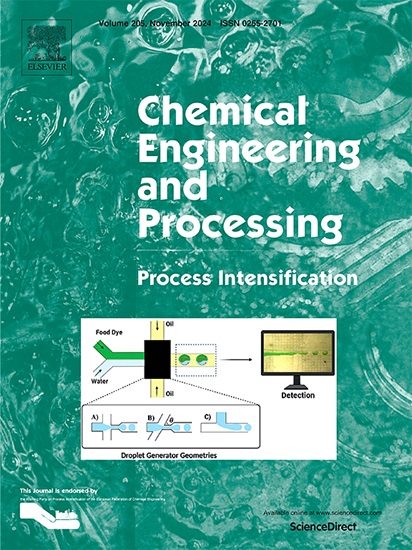Experimental investigation on an efficient continuous liquid-solid separator with particle automatic recovery and anti-damage
IF 3.9
3区 工程技术
Q3 ENERGY & FUELS
Chemical Engineering and Processing - Process Intensification
Pub Date : 2025-05-18
DOI:10.1016/j.cep.2025.110367
引用次数: 0
Abstract
Traditional liquid-solid separation technology has significant limitations in regulating particle morphology, increasing particle size, and realizing perfusion process because of low solid content, insufficient handling capacity, poor separation accuracy, and discontinuity. Therefore, a continuous liquid-solid separator (CLSS) with circulation settlement, microporous filtration, solid recycling, and extraction separation is proposed to achieve in-situ liquid-solid separation for efficient and continuous reaction in the multiphase reactor. Three typical solid materials (i.e., cathode material, aluminum hydroxide, and brown corundum) with different physical properties were employed to investigate the effects of operating parameters (i.e., solid feeding concentration, clear liquid handling capacity, and running time) on the slurry flow regime and separation performance. It is found that the defined slurry circulation and separation performance are affected by the coupling of particle properties and operating parameters. The filter intercepts almost 100 % of solid particles, achieving particle recycling and increasing solid concentration. The particle recovery concentration of the separator can reach more than 3 times the feeding concentration, enriching particle concentration more than 50 wt.%. The beneficial supergravity separation is promoted as the particle size increases, decreasing the particle axial diffusion along the separation zone. The mechanisms of slurry directional flow and solid-liquid separation in the CLSS are revealed through force analysis, which enhances particle retention and separation performance. The CLSS can transform some intermittent reactions into continuous ones, reducing production costs and improving product quality and safety, shedding new light on upgrading various industries, such as biological fermentation, solid catalysis, and reaction crystallization.

具有颗粒自动回收和抗损伤功能的高效连续液固分离器的实验研究
传统的液固分离技术由于固含量低、处理能力不足、分离精度差、不连续等缺点,在调节颗粒形态、增大颗粒大小、实现灌注过程等方面存在明显的局限性。为此,提出一种集循环沉降、微孔过滤、固体回收、萃取分离为一体的连续液固分离器(CLSS),实现多相反应器中高效连续反应的原位液固分离。采用三种具有不同物理性质的典型固体材料(正极材料、氢氧化铝和棕刚玉),研究了操作参数(固体进料浓度、清液处理量和运行时间)对料浆流动状态和分离性能的影响。研究发现,颗粒特性与操作参数的耦合影响了泥浆的循环和分离性能。过滤器拦截几乎100%的固体颗粒,实现颗粒回收,提高固体浓度。该分离器的颗粒回收浓度可达到进料浓度的3倍以上,富集颗粒浓度大于50wt .%。随着颗粒粒径的增大,有利于超重力分离的发生,颗粒沿分离带的轴向扩散减小。通过力分析揭示了CLSS中浆料定向流动和固液分离的机理,提高了颗粒的保留和分离性能。CLSS可以将一些间歇反应转化为连续反应,降低生产成本,提高产品质量和安全性,为生物发酵、固体催化、反应结晶等行业升级提供新的视角。
本文章由计算机程序翻译,如有差异,请以英文原文为准。
求助全文
约1分钟内获得全文
求助全文
来源期刊
CiteScore
7.80
自引率
9.30%
发文量
408
审稿时长
49 days
期刊介绍:
Chemical Engineering and Processing: Process Intensification is intended for practicing researchers in industry and academia, working in the field of Process Engineering and related to the subject of Process Intensification.Articles published in the Journal demonstrate how novel discoveries, developments and theories in the field of Process Engineering and in particular Process Intensification may be used for analysis and design of innovative equipment and processing methods with substantially improved sustainability, efficiency and environmental performance.

 求助内容:
求助内容: 应助结果提醒方式:
应助结果提醒方式:


